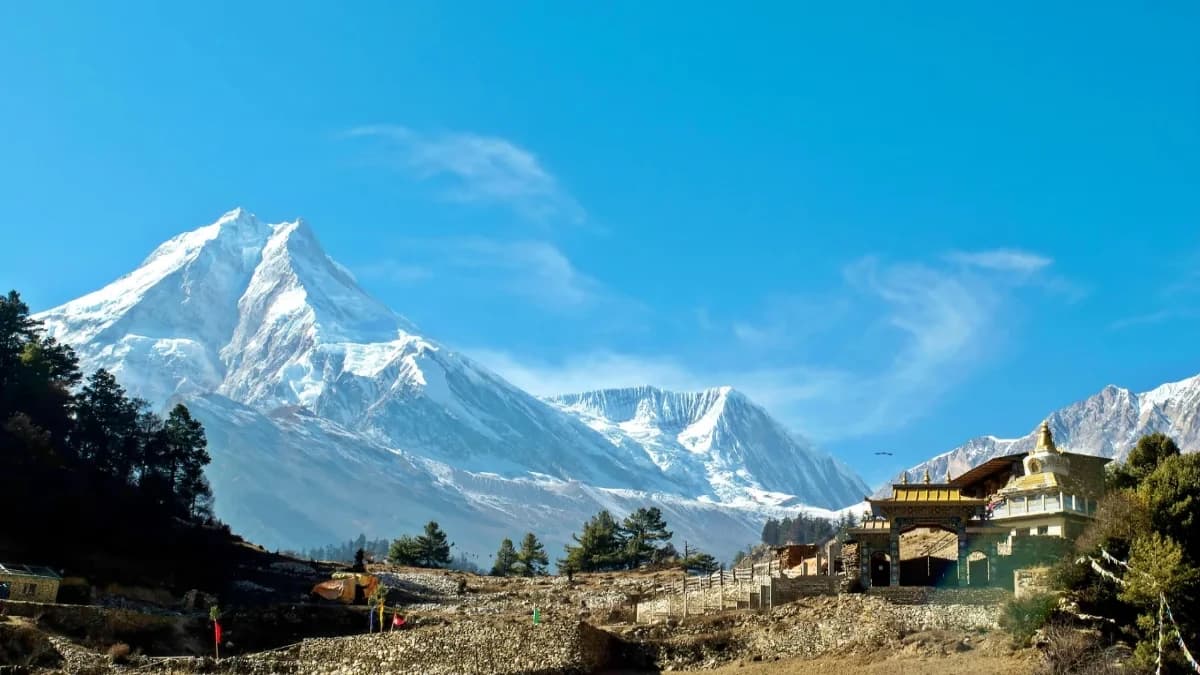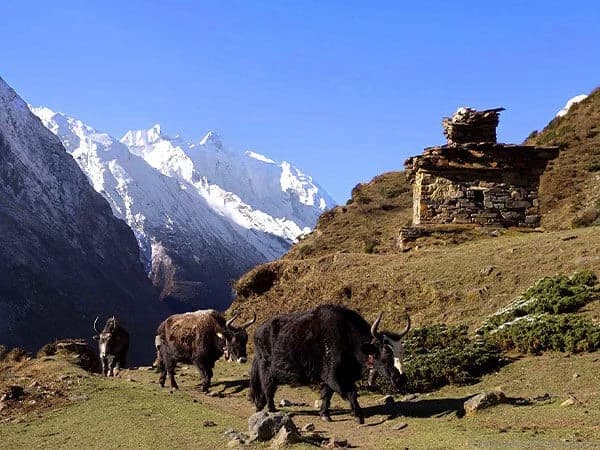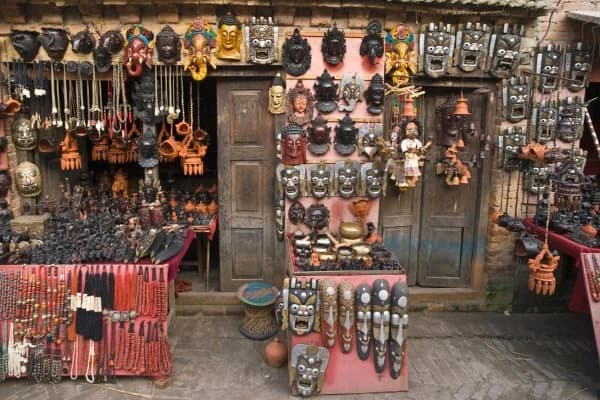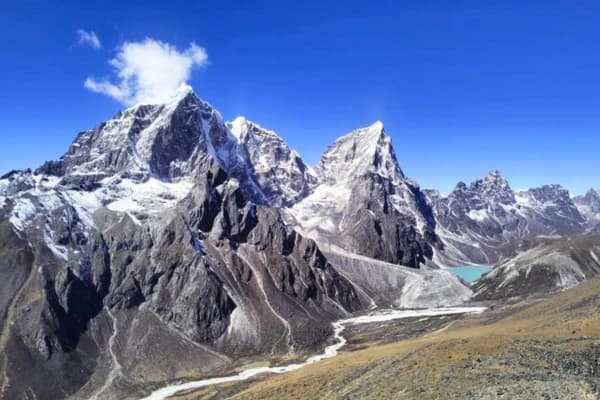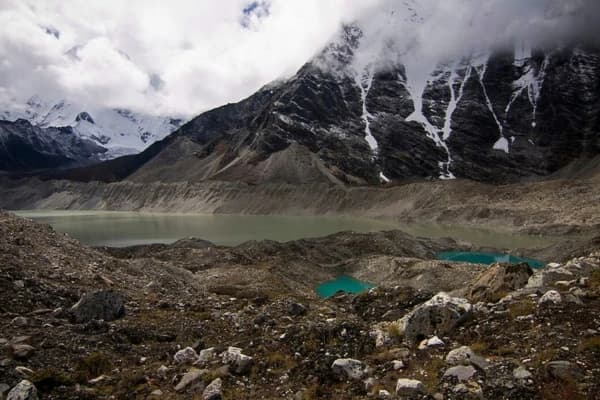The best time for Manaslu Circuit Tsum Valley Trek is Autumn (September–November) and Spring (March–May). These months provide the clearest skies, stable weather, and the most comfortable trekking conditions for both high passes and the Tsum Valley.
Autumn offers panoramic mountain views and bustling village life, while spring treats you to blooming rhododendrons and quieter trails. Trekking during these seasons ensures safer paths, ideal photography opportunities, and an immersive experience in local culture.
The Manaslu Circuit with Tsum Valley Trek is more than just a high-altitude trek; it takes you through remote Himalayan villages, old Tibetan Buddhist temples, and magnificent scenery. Choosing the proper season maximizes both safety and enjoyment, allowing you to fully appreciate the beauty and culture of this hidden Himalayan treasure.
Manaslu Circuit Tsum Valley Trek Season Overview
Your entire experience on the Manaslu Circuit with Tsum Valley Trek depends by the season you choose. Weather, trail conditions, and visibility vary greatly throughout the year, so understanding what each season has to offer allows you to choose the time that best suits your comfort and activity level.
Spring (March – May)
Spring is one of the most enchanting times to trek the Manaslu Circuit. Rhododendrons, wildflowers, and new plants bloom in the valleys and hillsides as the snow melts. The mild temperatures make it ideal for exploring Tsum Valley and trekking in the high mountains. With fewer trekkers on the trails, you can enjoy a peaceful and truly memorable adventure.
Pros:
- Clear skies and breathtaking panoramic mountain views at every turn
- Experience local culture through Tibetan Buddhist festivals in the villages
- Moderate, comfortable temperatures for day treks and high-altitude passes
Cons:
- Occasional rain showers can make some trails muddy
- River crossings may swell slightly due to snowmelt
Autumn (September – November)
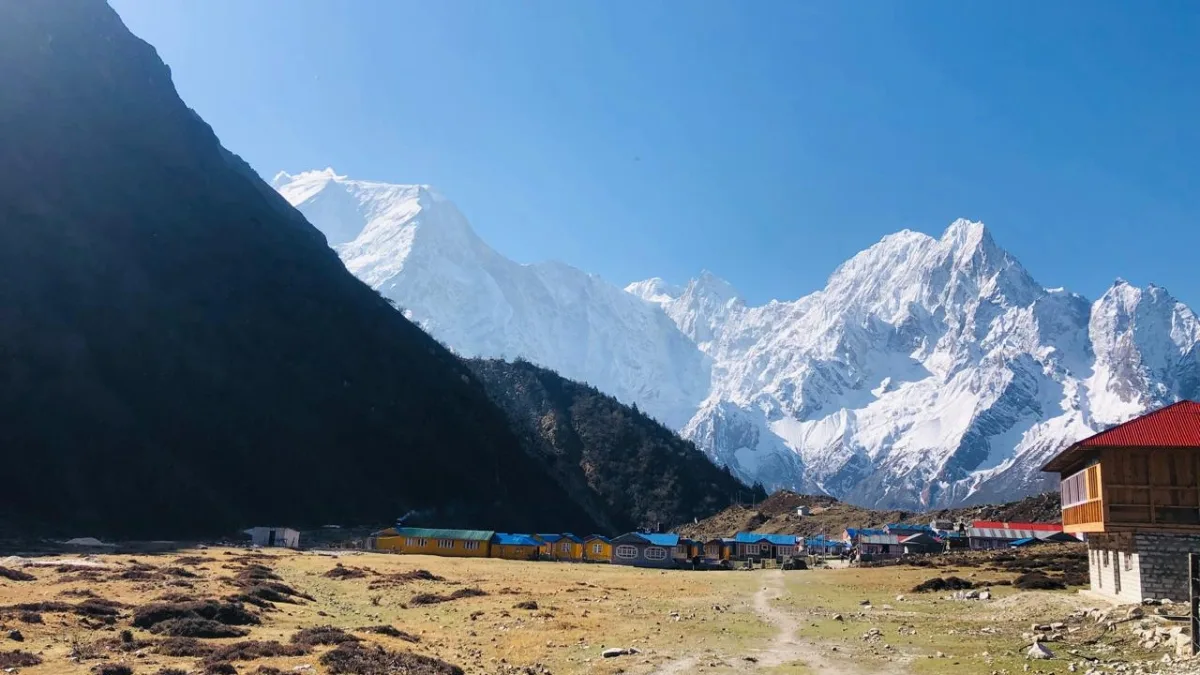
Autumn is the most suitable time for trekking and one of the best periods to complete the Manaslu Circuit Tsum Valley. The monsoon rains clear the skies, creating stable weather and excellent visibility of the Himalayan peaks. This season is ideal for photographers, culture enthusiasts, and trekkers looking for beautiful weather and spectacular landscape.
Pros:
- Gorgeous, clear skies and colorful landscapes make every step a perfect photo moment
- Get a firsthand look at local life through festivals and traditional celebrations in the villages
- Take in breathtaking, wide-ranging views from Larkya La Pass and the surrounding Himalayan peaks
Cons:
- Crowded trails due to peak season popularity
- Higher accommodation costs in tea houses and lodges
If you want to trek only Manaslu, Manaslu Circuit Trek is the best option for you.
Summer/Monsoon (June – August)
Trekking during summer and the monsoon is less popular but offers a unique experience for adventurous travelers. Early summer (June) can still be warm and green, while the monsoon (July–August) brings heavy rainfall, transforming the valleys into vibrant landscapes with flowing rivers and abundant waterfalls. The Tsum Valley is especially serene during this time, with fewer trekkers around.
Pros:
- Walk through green valleys and colorful landscapes full of life.
- Listen to rivers and waterfalls flowing along the trail.
- Enjoy quiet paths with few people, making the trek peaceful and calm.
Cons:
- Slippery trails and leeches on paths
- Higher risk of landslides and trail disruptions
- Potential cancellations or delays due to heavy rain
Winter (December – February)
Winter trekking is perfect for anyone who loves peace and snowy landscapes. High passes like Larkya La are covered in snow, and the villages are much quieter than at other times of the year. The skies are clear, the air is crisp, and the mountain views are stunning, but be prepared for very cold nights.
Pros:
- Quiet trails with almost no crowds
- Scenic snowy landscapes, ideal for those who love winter trekking
Cons:
- Very cold temperatures at higher altitudes
- Challenging trails, not recommended for beginners
- Fewer places to stay and eat in remote villages
Are you thinking of trekking through stunning Manaslu Tsum Valley? If yes, read our complete guide to Manaslu Tsum Valley trek and prepare yourself for snowy adventure.
How Cold Is the Manaslu Circuit Tsum Valley in Different Seasons?
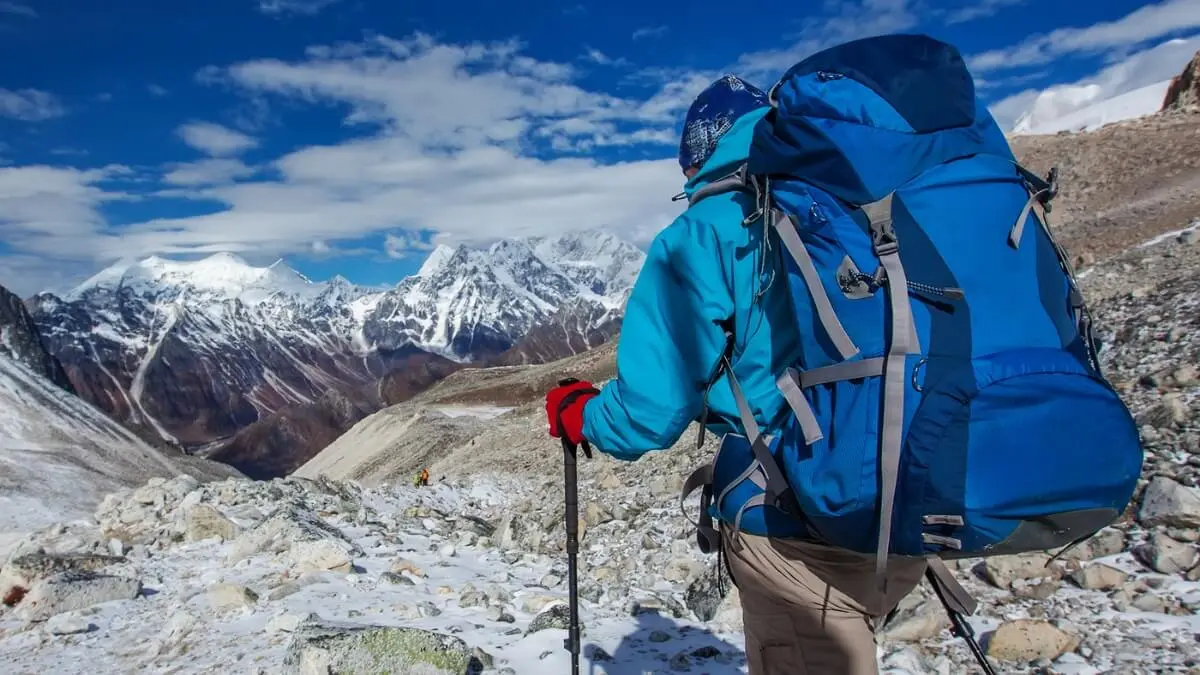
Knowing the temperatures on the Manaslu Circuit with Tsum Valley Trek helps you pack smart and stay comfortable. The weather changes a lot between the lower villages and high passes, so understanding each season makes your trek safer and more enjoyable.
|
Season |
Lower Region (2,000–3,500m) - Day |
Lower Region - Night |
High Region (4,000–5,160m) - Day |
High Region - Night |
Notes for Trekkers |
|
Spring (Mar–May) |
10°C to 17°C |
0°C to 5°C |
2°C to 10°C |
-5°C to -1°C |
Pleasant trekking weather; rhododendron bloom; occasional late-spring showers. |
|
Autumn (Sep–Nov) |
12°C to 20°C |
2°C to 7°C |
0°C to 8°C |
-6°C to -2°C |
Most stable season; crystal-clear views; best photography conditions. |
|
Monsoon (Jun–Aug) |
15°C to 22°C |
7°C to 12°C |
5°C to 12°C |
0°C to 5°C |
Very wet; slippery trails; leeches; frequent landslides in lower areas. |
|
Winter (Dec–Feb) |
0°C to 8°C |
-5°C to -10°C |
-10°C to -2°C |
-15°C to -20°C |
Extreme cold; heavy snow; Larkya La Pass often closed; only for experienced trekkers. |
Which is the Peak Season for the Manaslu Circuit Tsum Valley Trek?
The peak trekking season for the Manaslu Circuit with Tsum Valley Trek is Autumn (September to November). During this period, the monsoon rains have receded, leaving behind clear skies, stable weather, and breathtaking mountain views. Spring (March–May) is also popular, thanks to blooming rhododendrons, moderate temperatures, and quieter trails.
Peak season brings the advantage of well-established tea houses, available guides, and safe trail conditions, making it ideal for first-time trekkers. However, this also means more trekkers on the trails and slightly higher accommodation costs.
Is Winter Recommended for the Manaslu Circuit with Tsum Valley Trek?
Winter trekking in the Manaslu region (December to February) offers a completely different experience compared to other seasons, quiet trails, crisp air, and stunning snow-covered landscapes. But the big question is: Is winter a recommended time for the Manaslu Circuit with Tsum Valley Trek?
Winter is not recommended for most trekkers, especially beginners.
However, it can be recommended for highly experienced trekkers who are prepared for extreme cold and challenging trail conditions.
Why Winter Is Not Ideal for Most Trekkers?
Winter in the Manaslu region is harsh, especially above 3,500m. Places like Samagaun, Samdo, Dharmasala, and Larkya La Pass (5,160m) get extremely cold, often dropping to –15°C to –20°C at night.
Some of the key challenges include:
- Heavy snowfall that can block or hide trails
- Larkya La Pass often becomes impassable due to ice and snow
- Limited tea house availability in higher villages
- Shorter daylight hours, making the trek slower and riskier
- Increased chance of frostbite and altitude sickness
- Difficulty navigating, as snow often covers trail signs
Because of these conditions, guides and local authorities often discourage winter attempts, especially for trekkers with little high-altitude experience.
When Can Winter Be Recommended?
Despite the challenges, winter can be rewarding if you meet certain conditions:
- You have previous experience above 4,500m in winter conditions
- You hire an experienced Manaslu-certified guide
- You are well-prepared with winter gear (down jacket, crampons, thermal layers, proper boots)
- You enjoy solitude and snow-covered Himalayan landscapes
- You understand the risks and have a flexible itinerary
Weather and Trail Conditions
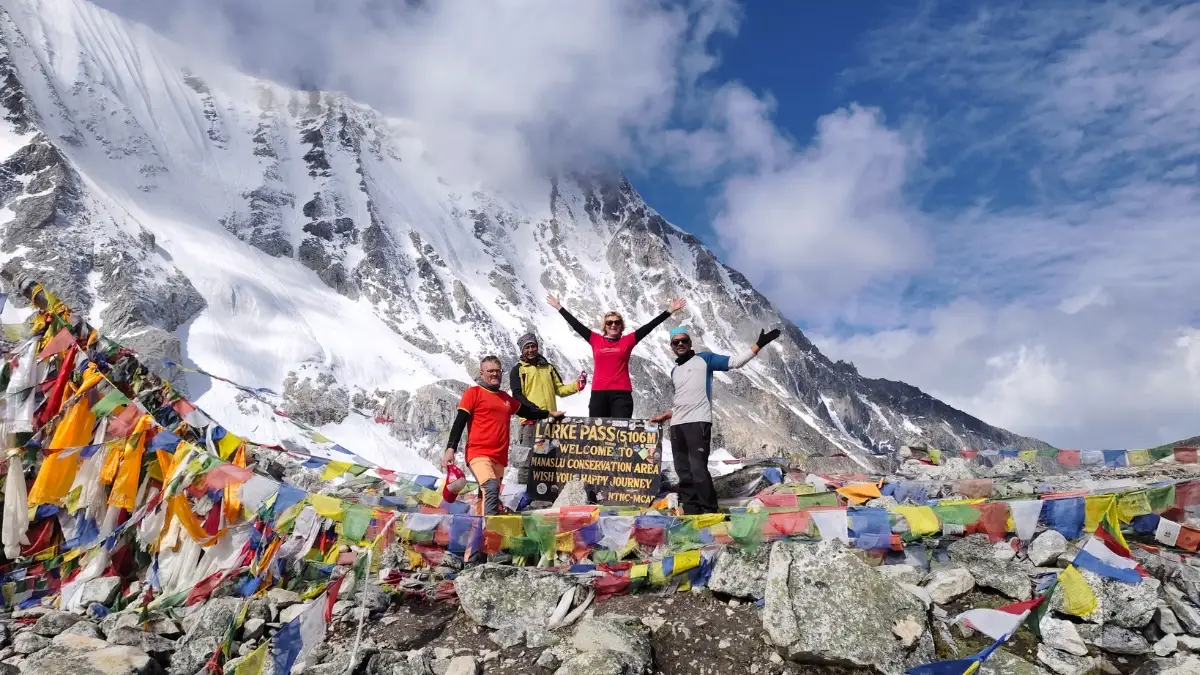
The weather on the Manaslu Circuit with Tsum Valley Trek changes a lot as you go higher. You start in warm villages at 700–900m and climb up to the snowy Larkya La Pass at 5,160m. Along the way, you’ll pass through different climates, so knowing the seasons helps you stay safe and enjoy the trek.
Seasonal Temperatures and Precipitation
- Spring (March–May) brings gradually warming temperatures and stable weather. Mornings are usually crisp, afternoons pleasant, and evenings chilly. Rainfall is low in early spring but becomes more frequent from late April onward. Higher sections may still have snow from winter.
- Autumn (September–November) is the most reliable season with minimal rainfall, clear skies, and mild daytime temperatures. This is the period when visibility is at its best, offering panoramic views of mount Manaslu, Himalchuli, Ganesh Himal, and the surrounding peaks.
- Monsoon (June–August) has the heaviest rainfall. Lower sections such as Soti Khola, Jagat, and Philim receive frequent showers, and trails become muddy and slippery. Rising river levels make crossings more challenging. Cloud cover also reduces visibility in Tsum Valley and around Samagaun.
- Winter (December–February) sees freezing temperatures, especially above 3,500m. Snowfall is common at Samdo, Dharmasala, and Larkya La Pass, making the high route more technical. Daylight hours are shorter, and conditions can change quickly.
River Crossings and Water Levels
Many sections of the Manaslu trail run alongside the Budhi Gandaki River. In monsoon, water levels rise significantly, making suspension bridges essential and sometimes risky due to heavy winds and overflowing streams. Small side streams from melting snow in spring may also require careful crossing.
In winter, riverbanks can become icy, increasing the risk of slips when approaching bridges.
Challenges at Larkya La Pass
The situation at Larkya La Pass, the trek's highest and most difficult point, are largely seasonal:
- In Spring and Autumn: The pass is usually clear, with well-defined trails and manageable wind conditions. These are the most recommended times for crossing.
- In Winter: Snow accumulation can hide trail markers, and ice makes the ascent and descent extremely slippery. Strong winds also make the crossing dangerous.
- In Monsoon: Rain, fog, and unstable ground conditions significantly increase risk, and visibility is usually poor.
Because of these challenges, trekkers often begin the ascent to Larkya La before sunrise, allowing enough time to cross safely before afternoon winds pick up.
Tips for Choosing the Best Time for Manaslu Circuit Tsum Valley Trek
Picking the right season can make your Manaslu Circuit with Tsum Valley Trek safer, more comfortable, and more enjoyable. Here are some practical tips based on weather, trail conditions, and high-altitude trekking.
Avoid Monsoon Hazards
- Heavy rain makes trails slippery and muddy
- Higher risk of landslides and rockfalls
- Cloudy skies limit photographic options and reduce visibility.
- In lower forested areas, leeches are prevalent.
- Roads leading to Soti Khola or Arughat may be blocked.
Optimize Photography and Cultural Experiences
- Autumn: Clear skies, long-range mountain views, and golden light perfect for photos
- Spring: Blooming rhododendrons, lush forests, and colorful landscapes
- Spring Festivals: Time your trek with local Tibetan-influenced celebrations like Lhosar
- Autumn Peaks: Take pictures of the snow-covered mountains around Larkya La, Samdo, and Samagaun.
Prepare for Altitude and Health Precautions
- Include acclimatization days in Namrung, Samagaun, and Samdo
- Drink plenty of water and avoid rushing your ascent
- Watch for AMS symptoms like headache, nausea, or breathlessness
- Bring warm layers for chilly nights even in Spring and Autumn
- Use medication like Diamox only under medical guidance
- Follow a reliable itinerary instead of pushing too far each day
Final Thoughts
The best time for Manaslu Circuit Tsum Valley Trek is clearly Autumn and Spring, the seasons with stable weather, clear views, and comfortable temperatures.
Before heading out, make sure your permits are ready, check the latest weather updates, and get guidance from trusted local experts.
For easy planning and a safe trekking experience, contact Nepal Gateway Trekking for professional support and customized trek arrangements.
FAQ
Is Manaslu Circuit with Tsum Valley Trek suitable for first-time trekkers?
It is not ideal for complete beginners. Manaslu Circuit with Tsum Valley Trek includes long walking days, remote trails, and high altitude above 5,000m. Trekkers need good fitness and previous multi-day trekking experience.
How long does the Manaslu Circuit with Tsum Valley Trek take?
The full combination trek usually takes 18–23 days. This includes acclimatization days, cultural exploration in Tsum Valley, and the climb to Larkya La Pass (5,160m).
What is the best time to do Manaslu Circuit with Tsum Valley Trek?
The best time is Autumn (Sept–Nov) and Spring (Mar–May). These seasons provide clear skies, comfortable temperatures, and safer trails.
Is the Manaslu Circuit with Tsum Valley Trek difficult?
Yes. The trek is considered moderate to challenging due to steep ascents, high altitude, long distances, and basic facilities. The crossing of Larkya La Pass adds to the difficulty level.
What permits do I need for Manaslu Circuit with Tsum Valley Trek?
To trek in the Manaslu region, you’ll need the following permits:
- Manaslu Restricted Area Permit (RAP)
- Tsum Valley Restricted Area Permit
- Manaslu Conservation Area Permit (MCAP)
No TIMS card is usually required for this region.
Is a guide compulsory for Manaslu Circuit with Tsum Valley Trek?
Yes. Both Manaslu and Tsum Valley are restricted areas, so a licensed guide and a registered trekking company are mandatory.
Can I trek Manaslu Circuit with Tsum Valley during monsoon?
It is not recommended. Heavy rain, landslides, muddy trails, and poor visibility make monsoon trekking unsafe. Autumn and spring remain the ideal seasons.
Which villages are the cultural highlights of Manaslu Circuit with Tsum Valley?
Must-visit villages include Sama Gaun, Samdo, Lho, Jagat, Chhekampar, and Nile. These offer monasteries, Tibetan-influenced culture, and stunning viewpoints.
What is the highest altitude reached during the trek?
The highest point is Larkya La Pass at 5,160 meters, a long and challenging crossing that requires proper acclimatization.
Are tea houses available throughout Manaslu and Tsum Valley?
Yes, but they are basic. Expect simple rooms, limited menus, and shared toilets. Facilities decrease the deeper you go into Tsum Valley.
